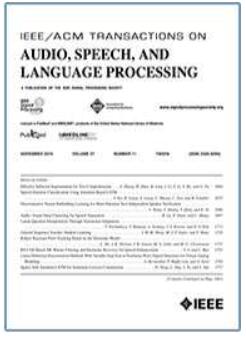用于大规模麦克风阵列的深克罗内克乘积波束成形
IF 5.1
2区 计算机科学
Q1 ACOUSTICS
IEEE/ACM Transactions on Audio, Speech, and Language Processing
Pub Date : 2024-09-12
DOI:10.1109/TASLP.2024.3459430
引用次数: 0
摘要
尽管基于深度学习的波束成形器在使用小型麦克风阵列时取得了可喜的性能,但在极具挑战性的环境中,例如信噪比(SNR)极低的环境中(例如,SNR $\le$-10 dB),它们的性能会下降。由数十个或数百个麦克风组成的大规模麦克风阵列具有很高的空间分辨率,因此可以提高波束成形器在这些具有挑战性的场景中的性能。但麦克风数量的急剧增加会导致特征冗余,给特征提取和网络训练带来困难。为了提高深度波束成形器在极具挑战性的场景中进行语音提取的性能,本文从以下两个方面入手,提出了一种适用于大规模麦克风阵列的新型全神经克朗克积波束成形方法(ANKP-BF)。首先,与小型麦克风阵列相比,大型麦克风阵列能提供更高的空间滤波性能,而深度神经网络在语音提取任务中具有强大的非线性建模能力,因此本文引入了深度神经网络。其次,通过引入 Kronecker 乘积规则,将原始的一个高维权重向量分解为两个低得多的权重向量的 Kronecker 乘积,解决了特征冗余问题。所提出的 ANKP-BF 设计为端到端方式。利用 DNS-Challenge 语料库和 WSJ0-SI84 语料库对模拟的大规模麦克风阵列信号进行了广泛的实验,同时还利用半消声室和室外场景中的真实录音来评估和比较不同方法的性能。定量结果表明,所提出的方法在多个客观指标上都优于现有的先进基线,尤其是在信噪比非常低的环境中。本文章由计算机程序翻译,如有差异,请以英文原文为准。
Deep Kronecker Product Beamforming for Large-Scale Microphone Arrays
Although deep learning based beamformers have achieved promising performance using small microphone arrays, they suffer from performance degradation in very challenging environments, such as extremely low Signal-to-Noise Ratio (SNR) environments, e.g., SNR
$\le$
求助全文
通过发布文献求助,成功后即可免费获取论文全文。
去求助
来源期刊

IEEE/ACM Transactions on Audio, Speech, and Language Processing
ACOUSTICS-ENGINEERING, ELECTRICAL & ELECTRONIC
CiteScore
11.30
自引率
11.10%
发文量
217
期刊介绍:
The IEEE/ACM Transactions on Audio, Speech, and Language Processing covers audio, speech and language processing and the sciences that support them. In audio processing: transducers, room acoustics, active sound control, human audition, analysis/synthesis/coding of music, and consumer audio. In speech processing: areas such as speech analysis, synthesis, coding, speech and speaker recognition, speech production and perception, and speech enhancement. In language processing: speech and text analysis, understanding, generation, dialog management, translation, summarization, question answering and document indexing and retrieval, as well as general language modeling.
 求助内容:
求助内容: 应助结果提醒方式:
应助结果提醒方式:


